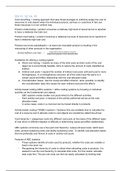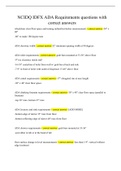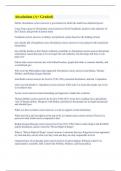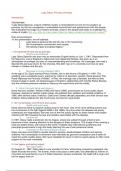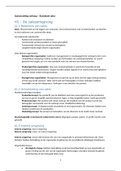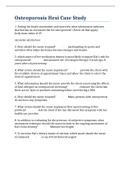CH 11, 12, 14, 15
Cost smoothing = costing approach that uses broad averages to uniformly assign the cost of
resources to cost objects when the individual products, services or customers in fact use
those resources in a non-uniform way.
Product undercosting = product consumes a relatively high level of resources but is reported
to have a relatively low total cost.
Product overcosting = product consumes a relatively low level of resources but is reported to
have a relatively high total cost.
Product-cost cross-subsidisation = at least one miscosted product is resulting in the
miscosting of other products in the organisation.
Guidelines for refining a costing system:
● Direct-cost tracing = classify as many of the total costs as direct costs of the cost
object as is economically feasible. Aims to reduce the amount of costs classified as
indirect.
● Indirect-cost pools = expand the number of indirect-cost pools until each pool is more
homogeneous. In a homogeneous cost pool, all of the costs have the same or a
similar cause-and-effect relationship with the cost-allocation base.
● Cost-allocation bases. Use the cause-and-effect criterion, when possible, to identify
the cost-allocation base (the cause) for each indirect-cost pool (the effect).
Activity-based costing (ABC) systems = refine costing systems by focusing on individual
activities as the fundamental cost objects.
- ABC systems create smaller cost pools linked to the different activities.
- Each activity-cost pool, a measure of the activity performed serves as the cost-
allocation base.
- In some cases, costs in a cost pool can be traced directly to products.
Activity-based costing (TDABC) systems = Systems that use available time to calculate the
cost of a resource and to allocate costs to cost objects are sometimes called time-driven.
Cost hierarchy = categorises costs into different cost pools on the basis of the different types
of cost driver or different degrees of difficulty in determining cause-and-effect relationships.
ABC systems commonly use a four-part cost hierarchy: output-unit-level costs, batch-level
costs, product-sustaining costs and facility-sustaining costs. To identify cost-allocation bases
that are preferably cost drivers of costs in activity-cost pools.
Features of ABC systems:
- These systems identify all costs used by products, whether the costs are variable or
fixed in the short run.
- Recognising the hierarchy of costs is critical when allocating costs to products. It is
easiest to use the cost hierarchy to calculate total costs. For this reason calculate
total costs first. The per-unit costs can then be easily calculated by dividing total
, costs by the number of units produced.
Activity-based management (ABM) describes management decisions that use activity-based
costing information to satisfy customers and manage profitability.
Using department indirect-cost rates to allocate costs to products results in the same product
costs as activity-cost rates if
(1) a single activity accounts for a sizeable fraction of the department’s costs, or
(2) significant costs are incurred on different activities within a department but each activity
has the same cost-allocation base, or
(3) significant costs are incurred on different activities with different cost-allocation bases
within a department but different products use resources from the different activity areas in
the same proportions.
Where any one of these three conditions holds, using department indirect-cost rates rather
than activity rates is often adequate. In companies where none of these conditions hold,
department-costing systems can be refined using ABC.
Emphasising activities leads to more focused and homogeneous cost pools, and aids in
identifying activity-cost-allocation bases that have a better cause-and-effect relationship with
the costs in activity-cost pools. But the benefits of an ABC system must be balanced against
its costs and limitations.
Key factor affecting pricing decisions is the customer’s willingness to pay.
Short-run decisions include (1) pricing for a one-off special order with no long-term
implications, and (2) adjusting product mix and output volume in a competitive market.
The starting point for pricing decisions can be:
- market-based
- cost-based (also called cost-plus).
The market-based approach to pricing starts by asking: Given what our customers want and
how our competitors will react to what we do, what price should we charge?
The cost-based approach to pricing starts by asking: What does it cost us to make this
product, and hence what price should we charge that will recoup our costs and produce a
desired profit?
Both approaches consider customers, competitors and costs. Only their starting points differ.
Under the cost-plus approach, price is first calculated on the basis of the costs to produce
and sell a product. Typically, a mark-up, representing a reasonable return, is added to cost.
Target price is the estimated price for a product (or service) that potential customers will be
willing to pay.
Target cost per unit is the estimated long-run cost per unit of a product (or service) that,
when sold at the target price, enables the company to achieve the target operating profit per
unit.
Two key concepts in value engineering and in managing value-added and non-value-added
costs are cost incurrence and locked-in costs. Cost incurrence occurs when a resource is
sacrificed or used up.
Cost smoothing = costing approach that uses broad averages to uniformly assign the cost of
resources to cost objects when the individual products, services or customers in fact use
those resources in a non-uniform way.
Product undercosting = product consumes a relatively high level of resources but is reported
to have a relatively low total cost.
Product overcosting = product consumes a relatively low level of resources but is reported to
have a relatively high total cost.
Product-cost cross-subsidisation = at least one miscosted product is resulting in the
miscosting of other products in the organisation.
Guidelines for refining a costing system:
● Direct-cost tracing = classify as many of the total costs as direct costs of the cost
object as is economically feasible. Aims to reduce the amount of costs classified as
indirect.
● Indirect-cost pools = expand the number of indirect-cost pools until each pool is more
homogeneous. In a homogeneous cost pool, all of the costs have the same or a
similar cause-and-effect relationship with the cost-allocation base.
● Cost-allocation bases. Use the cause-and-effect criterion, when possible, to identify
the cost-allocation base (the cause) for each indirect-cost pool (the effect).
Activity-based costing (ABC) systems = refine costing systems by focusing on individual
activities as the fundamental cost objects.
- ABC systems create smaller cost pools linked to the different activities.
- Each activity-cost pool, a measure of the activity performed serves as the cost-
allocation base.
- In some cases, costs in a cost pool can be traced directly to products.
Activity-based costing (TDABC) systems = Systems that use available time to calculate the
cost of a resource and to allocate costs to cost objects are sometimes called time-driven.
Cost hierarchy = categorises costs into different cost pools on the basis of the different types
of cost driver or different degrees of difficulty in determining cause-and-effect relationships.
ABC systems commonly use a four-part cost hierarchy: output-unit-level costs, batch-level
costs, product-sustaining costs and facility-sustaining costs. To identify cost-allocation bases
that are preferably cost drivers of costs in activity-cost pools.
Features of ABC systems:
- These systems identify all costs used by products, whether the costs are variable or
fixed in the short run.
- Recognising the hierarchy of costs is critical when allocating costs to products. It is
easiest to use the cost hierarchy to calculate total costs. For this reason calculate
total costs first. The per-unit costs can then be easily calculated by dividing total
, costs by the number of units produced.
Activity-based management (ABM) describes management decisions that use activity-based
costing information to satisfy customers and manage profitability.
Using department indirect-cost rates to allocate costs to products results in the same product
costs as activity-cost rates if
(1) a single activity accounts for a sizeable fraction of the department’s costs, or
(2) significant costs are incurred on different activities within a department but each activity
has the same cost-allocation base, or
(3) significant costs are incurred on different activities with different cost-allocation bases
within a department but different products use resources from the different activity areas in
the same proportions.
Where any one of these three conditions holds, using department indirect-cost rates rather
than activity rates is often adequate. In companies where none of these conditions hold,
department-costing systems can be refined using ABC.
Emphasising activities leads to more focused and homogeneous cost pools, and aids in
identifying activity-cost-allocation bases that have a better cause-and-effect relationship with
the costs in activity-cost pools. But the benefits of an ABC system must be balanced against
its costs and limitations.
Key factor affecting pricing decisions is the customer’s willingness to pay.
Short-run decisions include (1) pricing for a one-off special order with no long-term
implications, and (2) adjusting product mix and output volume in a competitive market.
The starting point for pricing decisions can be:
- market-based
- cost-based (also called cost-plus).
The market-based approach to pricing starts by asking: Given what our customers want and
how our competitors will react to what we do, what price should we charge?
The cost-based approach to pricing starts by asking: What does it cost us to make this
product, and hence what price should we charge that will recoup our costs and produce a
desired profit?
Both approaches consider customers, competitors and costs. Only their starting points differ.
Under the cost-plus approach, price is first calculated on the basis of the costs to produce
and sell a product. Typically, a mark-up, representing a reasonable return, is added to cost.
Target price is the estimated price for a product (or service) that potential customers will be
willing to pay.
Target cost per unit is the estimated long-run cost per unit of a product (or service) that,
when sold at the target price, enables the company to achieve the target operating profit per
unit.
Two key concepts in value engineering and in managing value-added and non-value-added
costs are cost incurrence and locked-in costs. Cost incurrence occurs when a resource is
sacrificed or used up.


